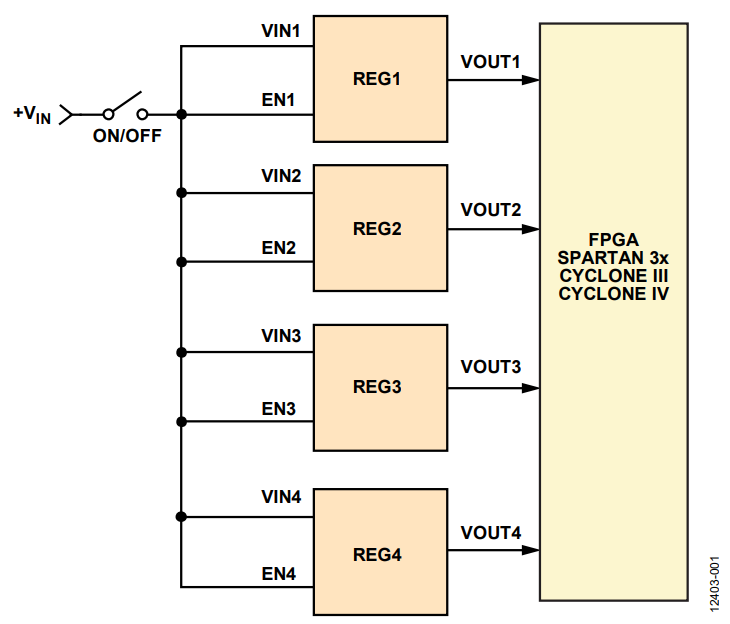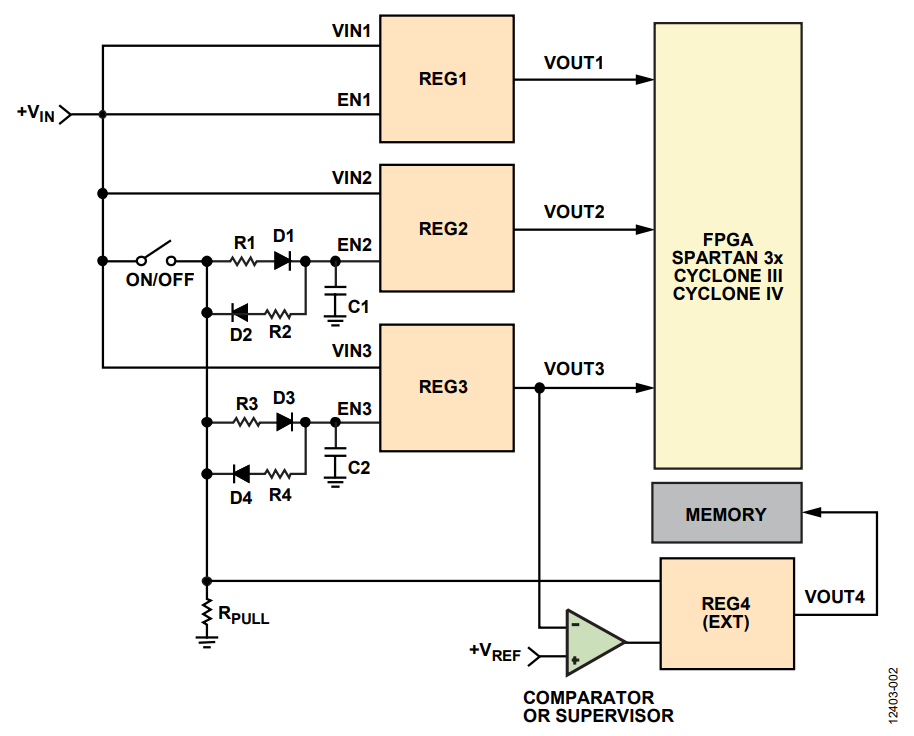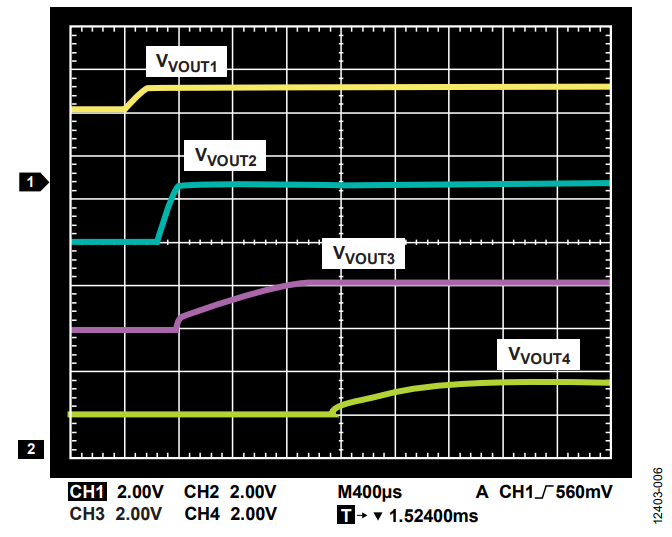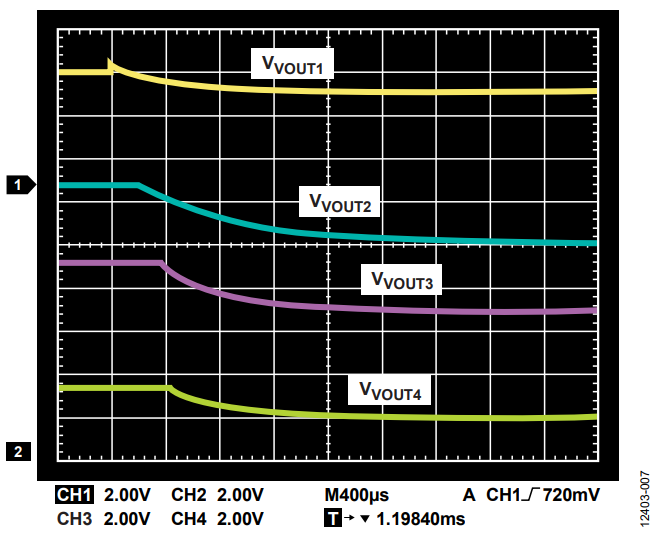AN-1311: Complex Power Supply Sequencing Made Easy
Introduction
Power supply sequencing is required for microcontrollers, field programmable gate arrays (FPGAs), digital signal processors (DSPs), analog-to-digital converters (ADCs), and other devices that operate from multiple voltage rails. These applications typically require that the core and analog blocks be powered up before the digital input/output (I/O) rails, although some designs may require other sequences. Proper power-up and power-down sequencing can prevent both immediate damage from latch-up and long-term damage from electrostatic discharge (ESD). In addition, sequencing the supplies staggers the inrush current during power-up, an especially helpful technique in applications operating from current-limited supplies.
This application note discusses the advantages and disadvantages of using discrete components to sequence the power supplies and describes a simple, yet effective, method of achieving sequencing by using the internal precision enable pins of the ADP5134, which combines two 1.2 A buck regulators with two 300 mA low dropout (LDO) regulators. This application note also describes sequencer ICs that may be useful for applications that require more accurate and flexible sequencing.
Figure 1 shows an application that requires multiple supply rails. These rails are the core supply (VCCINT), I/O supply (VCCO), auxiliary supply (VCCAUX), and system memory supply.

Figure 1. Typical Method for Powering Processors and FPGAs.
For example, the Xilinx® Spartan-3A FPGA has a built-in power-on reset circuit that ensures that all supplies have reached their thresholds before it allows the device to be configured. The power-on reset circuit reduces the strict requirement for power sequencing; however, to minimize inrush current levels and to observe sequencing requirements of circuits attached to the FPGA, the supply rails must be powered up as follows: VCCINT followed by VCCAUX followed by VCCO. Note that some applications require specific sequences; therefore, always refer to the power requirements section of the relevant data sheet.
Simple Power Supply Sequencing Using Passive Delay Networks
A simple way to sequence power supplies is to delay the signal going to the enable pin of a regulator with passive components, such as resistors, capacitors, and diodes, as shown in Figure 2. When the switch closes, D1 conducts while D2 is left open. C1 charges with the voltage at EN2 rising at a rate determined by R1 and C1. When the switch opens, C1 discharges to ground through R2, D2, and RPULL. The voltage at EN2 falls at a rate determined by R2, RPULL, and C1. Changing the values of R1 and R2 changes the charging and discharging times, thereby setting the turn-on and turn-off times of the regulator.

Figure 2. Simple Power Supply Sequencing Method Using Resistors, Capacitors, and Diodes.
This method may be useful for applications that do not require precise sequencing. Applications where delaying signals is sufficient may require only the external resistor and capacitor. The disadvantage of using this method with standard regulators is that the logic threshold of the enable pins may vary widely with voltage and temperature. In addition, the delay in the voltage ramp depends on the values and tolerances of the resistor and capacitor. A typical X5R capacitor varies by about ±15% over the –55°C to +85°C temperature range and another ±10% due to dc bias effects, making the timing imprecise and sometimes unreliable.
Precision Enables Make Sequencing Easy
To achieve stable threshold levels for precise timing control, most regulators require an external voltage reference. The ADP5134 overcomes this problem by integrating a precision reference, saving significant cost and printed circuit board (PCB) area. Each regulator has an individual enable input.
When the voltage at the enable input rises above the ENx pin rising threshold (VIH_EN [0.9 V minimum]), the device comes out of shutdown, and the housekeeping block is turned on; however, the regulator is not activated. The voltage at the enable input is compared to a precise internal reference voltage (0.97 V typical). When the voltage at the enable pin goes above the precision enable threshold, the regulator is activated, and the output voltage starts to rise. The reference varies by only ±3% over input voltage and temperature corners. This small range ensures precise timing control, resolving the issues seen with using discrete components.
When the voltage at the enable input drops 80 mV (typical) below the reference voltage, the regulator is deactivated. When the voltage on all enable inputs drops below the ENx falling threshold (VIL_EN [0.35 V maximum]), the device enters shutdown mode. In this mode, the current consumption falls to less than 1 µA. Figure 3 and Figure 4 demonstrate the accuracy of the ADP5134 precision enable thresholds for BUCK1 over temperature.

Figure 3. Precision Enable Turn-On Threshold over Temperature, 10 Samples.

Figure 4. Precision Enable Turn-Off Threshold over Temperature, 10 Samples.
Simple Power Supply Sequencing Using Resistor Dividers
Multichannel supplies can be sequenced by connecting an attenuated version of the output of one regulator to the enable pin of the next regulator to be powered up, as shown in Figure 5, where the regulators turn on or off sequentially: BUCK1 to BUCK2 to LDO1 to LDO2. Figure 6 shows the power-up sequence after EN1 is connected to VIN1. Figure 7 shows the shutdown sequence after EN1 is disconnected from VIN1.

Figure 5. Simple Sequencing with the ADP5134.

Figure 6. ADP5134 Start-Up Sequence.

Figure 7. ADP5134 Shutdown Sequence.
Sequencer ICs Improve Timing Accuracy
In some cases, achieving precise timing is more important than reducing PCB area and cost. For these applications, a voltage monitoring and sequencer IC such as the ADM1184 quad voltage monitor, which offers ±0.8% accuracy over voltage and temperature, can be used. Another choice is the ADM1186 quad voltage sequencer and monitor with programmable timing; this device may be useful in applications that require more elaborate
For example, the ADP5034 4-channel regulator includes two 3 MHz, 1200 mA buck regulators and two 300 mA LDOs. A typical sequencing function can be implemented by using the ADM1184 to monitor the output voltage of one regulator and to provide a logic high signal to the enable pin of the next regulator when the output voltage being monitored reaches a certain level. This method, shown in Figure 8, can be used with regulators that do not provide a precision enable function.

Figure 8. Sequencing the ADP5034 4-Channel Regulator Using the ADM1184 Quad Voltage Monitor.
Conclusion
Sequencing using the ADP5134 precision enable inputs is simple and easy to implement, requiring only two external resistors per channel. More elaborate sequencing can be achieved by using the ADM1184 or ADM1186 voltage monitors.
References
Xilinx DS529 Spartan-3A FPGA Family Data Sheet. Xilinx, Inc., 2010.
In addition, refer to the power management web page and the power management/sequencing web page for more information.
